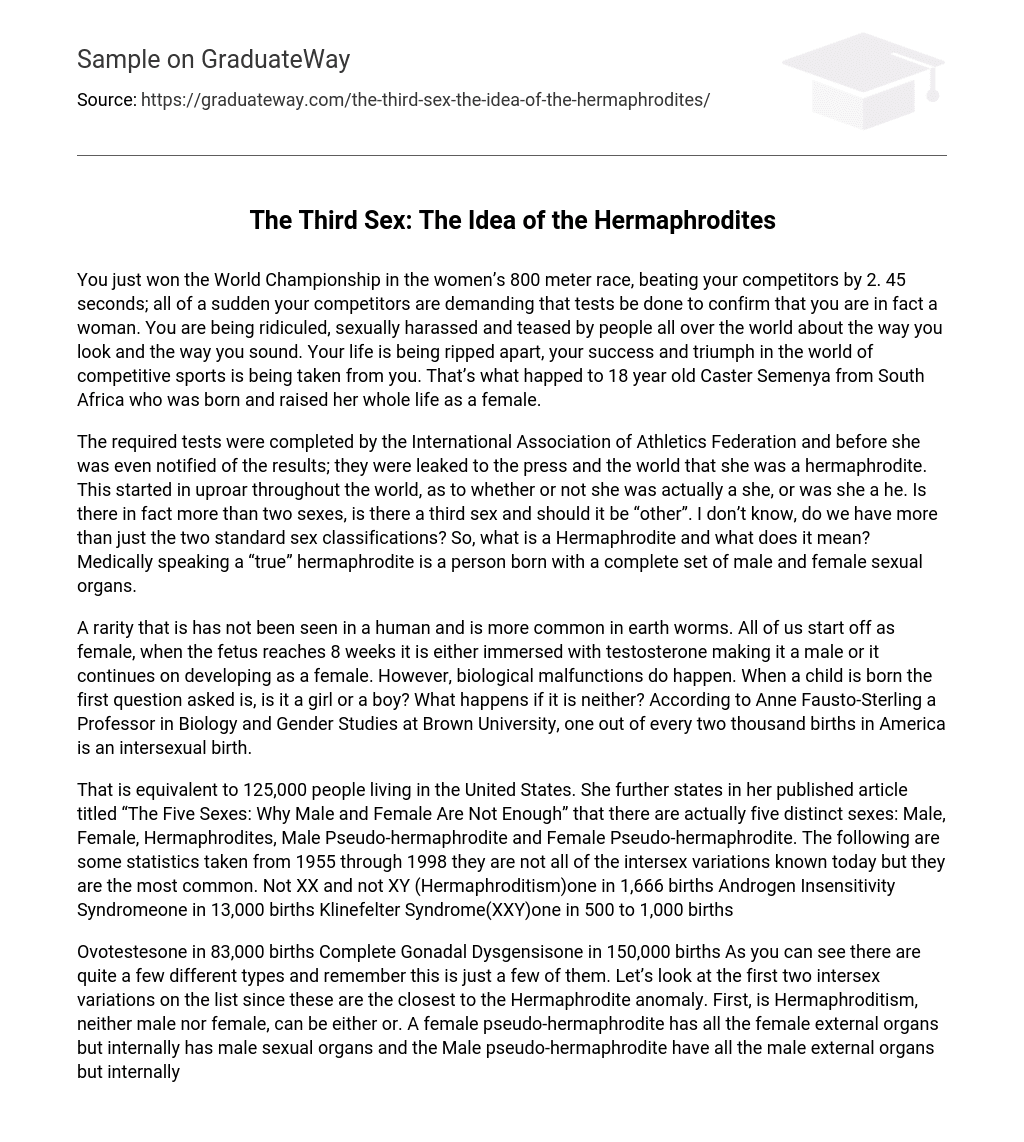You just won the World Championship in the women’s 800 meter race, beating your competitors by 2. 45 seconds; all of a sudden your competitors are demanding that tests be done to confirm that you are in fact a woman. You are being ridiculed, sexually harassed and teased by people all over the world about the way you look and the way you sound. Your life is being ripped apart, your success and triumph in the world of competitive sports is being taken from you. That’s what happed to 18 year old Caster Semenya from South Africa who was born and raised her whole life as a female.
The required tests were completed by the International Association of Athletics Federation and before she was even notified of the results; they were leaked to the press and the world that she was a hermaphrodite. This started in uproar throughout the world, as to whether or not she was actually a she, or was she a he. Is there in fact more than two sexes, is there a third sex and should it be “other”. I don’t know, do we have more than just the two standard sex classifications? So, what is a Hermaphrodite and what does it mean? Medically speaking a “true” hermaphrodite is a person born with a complete set of male and female sexual organs.
A rarity that is has not been seen in a human and is more common in earth worms. All of us start off as female, when the fetus reaches 8 weeks it is either immersed with testosterone making it a male or it continues on developing as a female. However, biological malfunctions do happen. When a child is born the first question asked is, is it a girl or a boy? What happens if it is neither? According to Anne Fausto-Sterling a Professor in Biology and Gender Studies at Brown University, one out of every two thousand births in America is an intersexual birth.
That is equivalent to 125,000 people living in the United States. She further states in her published article titled “The Five Sexes: Why Male and Female Are Not Enough” that there are actually five distinct sexes: Male, Female, Hermaphrodites, Male Pseudo-hermaphrodite and Female Pseudo-hermaphrodite. The following are some statistics taken from 1955 through 1998 they are not all of the intersex variations known today but they are the most common. Not XX and not XY (Hermaphroditism)one in 1,666 births Androgen Insensitivity Syndromeone in 13,000 births Klinefelter Syndrome(XXY)one in 500 to 1,000 births
Ovotestesone in 83,000 births Complete Gonadal Dysgensisone in 150,000 births As you can see there are quite a few different types and remember this is just a few of them. Let’s look at the first two intersex variations on the list since these are the closest to the Hermaphrodite anomaly. First, is Hermaphroditism, neither male nor female, can be either or. A female pseudo-hermaphrodite has all the female external organs but internally has male sexual organs and the Male pseudo-hermaphrodite have all the male external organs but internally has female sexual organs.
Upon birth if all external sexual organs are normal this person could go undiagnosed until puberty, when as a female they do not menstruate or as adults they explore why they can’t have children or some other medical issue reveals the truth. Understand that in the case of Caster Semenya, this was not revealed even at puberty due to her being an athlete. Most athletic girls never have a menstrual cycle due to their athletic regimen. Second, is Androgen Insensitivity Syndrome, also known as CAIS. This genetic condition occurs in approximately one in every 13,000 births.
In 1996 at the Atlanta Olympics eight female athletes failed the required sex test and were found to be not fully female and yet not a developed male. Tests showed that these women suffered from CAIS. People with this diagnosis are unable to respond to any Male Hormones also known as Androgens. They look completely female and have all the external sexual organs but have internal testes. Blood test will reveal that they have the X and Y chromosome that are required to be male; they will also show that there are no testosterone levels in their bodies.
Because of the inability to absorb the Androgens the body then breaks down the testosterone into female hormones, therefore, they are technically female. Nature doesn’t decide what constitutes a male, a female or an Intersex individual. Humans decide, doctors, parents, you. We all decide. Gender identity provides us with the most basic guide as to how we relate to others while it also affects the way in which we experience ourselves and our own gender identity. When gender identity is ambiguous in someone else, it challenges our conceptions of who we are.
As for Caster Semenya, to discover that her gender is no longer clear, places her in a transitional role, no longer able to claim she is a woman and yet unable to be a man. She has to make sense of the incongruity that she is now faced with between her body, now classified as a male and her mental experience as a woman While I have given you some of the facts and statistics pertaining to the medical conditions of hermaphrodites, I would like you to focus your attention on the underlying issues of our society’s views, influences and discriminations of hermaphrodites.
The example of Caster Semenya depicts this is totality and I challenge all of you to stop and think about the moral aspects involved. What if you were to find out that you, your child or a loved one was diagnosed with this medical condition? What would you do, how would you feel? Finally, try and remember that assignment of gender identity is something that is conferred and constructed – and is not simply a biological given.





